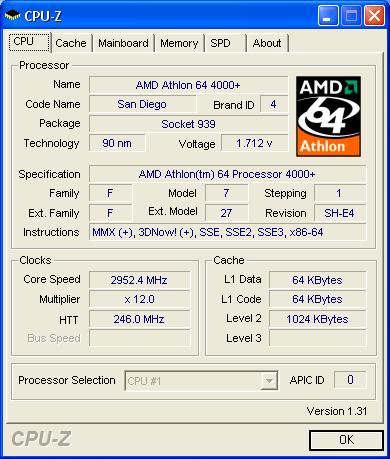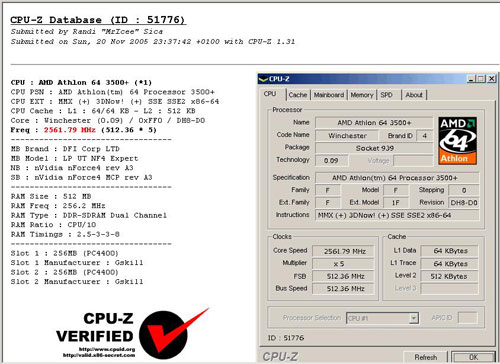DFI NF4 SLI-DR Expert – Can the best get better?
by Randi Sica on November 25, 2005 12:05 PM EST- Posted in
- Motherboards
DFI NF4 SLI-DR Expert: Overclocking
The 3500+ Winchester used in this review had previously run at 500 MHz FSB with extreme stability on the SLI-D. This was illustrated here. To reach that plateau on the SLI-D, it was necessary to boot into Windows at 425 MHz FSB and then utilize ClockGen to escalate to 500 MHz FSB as the board would not boot into Windows at any setting higher than 425 MHz FSB.
In contrast, the Expert had booted into Windows all the way to 510 MHz FSB. At that point, ClockGen was used to rise to the CPU’s limit of 512 MHz FSB.
It is worth pointing out that the board is only the vehicle to allow you the ability to overclock your CPU. The CPU’s ability to overclock, whether aiming for a top overclock or HTT overclock, or even a top 1:1 memory overclock, will be the over-riding factor in one’s success. Other factors, including the integrated memory controller of the A64, also contribute to the processors overclocking abilities.
Case in point is the difference between the 4000+ San Diego and the 3500+ Winchester. The 4000+ would clock the FSB easily to 400 MHz on the SLI-DR Expert, but no further, whereas the 3500+ attained an additional 112 MHz FSB. Too many times, one will blame the board when in fact the CPU is the main contributing factor.
| DFI LP UT NF4 SLI-DR Expert Overclocking Testbed | |
| Processor: | AMD A64 4000+ San Diego core AMD A64 3500+ Winchester core |
| CPU Voltage: | 1.41V- 1.73V |
| Cooling: | Custom watercooling setup: Lytron 6848G4 Modular watercooling system feeding a Swiftech MCW6000 waterblock |
| Power Supply: | PC Power and Cooling Turbo-Cool 510 SLI |
| Memory: | 2x256MB Corsair CMX256A-3200LL BH-5 2x256MB G.skill PC4400LE 2x512MB Corsair CMX512-3200XL 2x1GB Corsair CMX1024-4000PT 4x512MB OCZ PC4800EL Elite Platinum Ed. |
| Hard Drive: | Hitachi Deskstar 7200RPM 160 GB SATA |
| Maximum OC: (Standard Ratio) |
246x12 (5x LDT) 2952MHz (+18.7%) |
| Maximum FSB: (Lower Ratio) |
512Mhz x 5 (2.5x LDT) (2561MHz, 2 DIMMs in DC mode @ 256Mhz 2.5-3-3-8 1T) (+156% Bus Overclock) |

CPU-Z validation link
Compared to this reviewer’s experience with the original SLI-D, the Expert version is a superior overclocking platform. With DFI’s wide range of voltage options and overclocking settings, the board excels in assisting the enthusiast to get the most from any CPU. In the illustration of the Top Overclock, the 4000+ San Diego was used, watercooled, and had reached a highest clock of 2950 MHz in the original SLI-D. The Expert took this CPU to the same limit.The 3500+ Winchester used in this review had previously run at 500 MHz FSB with extreme stability on the SLI-D. This was illustrated here. To reach that plateau on the SLI-D, it was necessary to boot into Windows at 425 MHz FSB and then utilize ClockGen to escalate to 500 MHz FSB as the board would not boot into Windows at any setting higher than 425 MHz FSB.
In contrast, the Expert had booted into Windows all the way to 510 MHz FSB. At that point, ClockGen was used to rise to the CPU’s limit of 512 MHz FSB.
It is worth pointing out that the board is only the vehicle to allow you the ability to overclock your CPU. The CPU’s ability to overclock, whether aiming for a top overclock or HTT overclock, or even a top 1:1 memory overclock, will be the over-riding factor in one’s success. Other factors, including the integrated memory controller of the A64, also contribute to the processors overclocking abilities.
Case in point is the difference between the 4000+ San Diego and the 3500+ Winchester. The 4000+ would clock the FSB easily to 400 MHz on the SLI-DR Expert, but no further, whereas the 3500+ attained an additional 112 MHz FSB. Too many times, one will blame the board when in fact the CPU is the main contributing factor.











40 Comments
View All Comments
Hardass1 - Sunday, February 19, 2006 - link
Another well done review Sir.Hardass.
lopri - Saturday, November 26, 2005 - link
If you had to pick one, which one would you pick? A8N32-SLI or Expert? Please don't tell me "Both are good", "They're different animals" or anything in that sense. Most of us have to pick ONE and that exact question is what we want to know. I'd venture to say what matters are following two:1. Overclockability
2. Stability
Fetures, layouts, etc... yeah.. they are all good and nice, but what really matters are whether the overclock is stable. And that's what brought DFI here today. Could you comment on it? If you had a choice to pick JUST ONE, which one would you pick?
Great review anyway. I'm actually happy that AT is becoming more enthusiast-friendly and looking forward to the next review. (Possibly Opteron Overclocking review?)
Thanks.
lop
RSica - Sunday, November 27, 2005 - link
Hi Lop:)I'll be honest in telling you I have not had my hands on the Asus board to know it's full overclocking abilities, so I really can't give you an opinion on which board to choose. Wesley could give you full insight on that one.
I go way back in the overclocking business, having hooked up with my best buds OPPAINTER and DDTUNG back in the day. At that time we were modding and overclocking each generation of Abit AMD based boards starting with the KG7 and culminating with the NF7-S, which we were pre-production testing prior to it's retail release. I've also had a play with Epox, Gigabyte, and the famous Shuttle A64 board.When I recieved the original SLI-D back in January it was an overclockers dream come true.All the voltage and overclocking/memory options and it overclocked way easy compared to the norm.(Thank you Oskar Wu:))
The Expert is more of the same but much better. I am a bit biased on a personal level about the board, and if you had just asked about it, I'd have given a thumbs up.
Thanks for your comments !
Randi
Scrith - Wednesday, November 30, 2005 - link
Does this use the same chipset as the A8N32-SLI? If not, why not, and where are the competitors for that board?Heckler 5th - Sunday, December 4, 2005 - link
how come the box the reviewer received already has that "anandtech gold medal" sticker on there? hmmm, kinda fishy... LOLcbkia - Saturday, November 26, 2005 - link
Under the extreme oc page, the pic showing the HTT @ 400MHz and RAM @ 300MHZ 2.5-3-3-8 but the sisoft is only 6674 MB/s? 300MHz should be displaying something near 8GB/sRSica - Sunday, November 27, 2005 - link
That would be true if not running at 2400Mhz.All HTT and Memory overclocking tests were done at a reduced multiplier. Each multiplier also has an effect on system bandwidth in the way the A64 responds to them.If I had chosen to run 7 and a total CPU Mhz of 2800, you would have most likely seen the 8000mb/s figure.In contrast, the stock 4000+ at 12x200Mhz with tight timings will average 5600-5700mb/s.
Another consideration is that with the bios used which made it more ram overclocking friendly, that there was possibly a relaxation of some of the bios register settings, which can also reduce bandwidth a bit in the name of pushing the memory higher in Mhz.
Thanks for your comments !
Randi
RobFDB - Saturday, November 26, 2005 - link
What i'm really interested in is if this board suffers from the same problem as my Ultra-D with PC4000 VX memory (the infamous cold boot issue)?I don't really want to pick this board up and have it suffer from the same problem. Not that i've tried my VX with the latest beta bios, but that's besides the point.
RobFDB - Tuesday, November 29, 2005 - link
Can anyone confirm or deny that the cold boot issue exists with this board?yacoub - Saturday, November 26, 2005 - link
If it had passive cooling like the A8N32-SLI I'd be more interested.